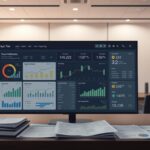Now Reading: AI Powered Cryptocurrency Trading Algorithms Explained
- 01
AI Powered Cryptocurrency Trading Algorithms Explained
AI Powered Cryptocurrency Trading Algorithms Explained

This guide shows how machine models sift vast, varied data to spot signals and act in a 24/7 crypto market.
Models use price history, volume, order books, social chatter, and blockchain events to shape entries and exits. That speed and scale can give traders millisecond responses and constant automation.
At the same time, quality of data, model drift, and herd behavior can erode gains. Risks like spoofing and overfitting mean clear guardrails and transparency are vital.
Later sections preview key strategies—arbitrage, market making, grid systems, dollar-cost averaging, high-frequency tactics, and sentiment signals. We also cover mainstream platforms such as Bybit’s TradeGPT, Pionex, CryptoHopper, HaasOnline, Kryll, and 3Commas that bring these tools to everyday traders.
From early Wall Street systems to always-on Web3 markets, the shift magnifies both opportunity and risk. This Ultimate Guide will map mechanisms, benefits, and practical next steps for U.S. traders seeking an informed, disciplined way into modern workflows.
Key Takeaways
- Machine models ingest diverse data to inform fast decisions in nonstop markets.
- Speed and objectivity are strong benefits; data quality and model drift are main limits.
- Common strategies include arbitrage, market making, grid, DCA, HFT, and sentiment signals.
- Platforms like Bybit TradeGPT, Pionex, and CryptoHopper package these methods for users.
- Always-on markets increase both opportunities and ethical or operational risks.
What Is AI-Powered Crypto Trading and How It Works
By training on labeled histories, models turn raw market feeds into ranked predictions and actionable rules. This process begins with cleaning and aligning candles, volumes, and order book snapshots so features match the target outputs.
Machine Learning on Past Data
Supervised learning maps past data to concrete outputs. Regression predicts continuous values such as next-price or spread, while classification flags buy/sell signals. Models train on labeled historical candles, volumes, and snapshots.
Unsupervised methods like clustering and PCA find hidden regimes and reduce indicator sets. That helps models generalize when markets shift.
Neural Networks and Deep Learning
Deep networks capture non-linear links among prices, indicators, order flow, and volume. These architectures spot complex patterns and short-term trends that simple rules miss.
Data Analytics and NLP
NLP pipelines convert news and social media into sentiment and relevance scores. Those signals join market data in backtests to improve predictions and refine feature sets.
24/7 Automation in Production
From ingestion to deployment, the flow goes: feature engineering, model training, validation, and automated bots. In live runs, latency-sensitive systems monitor venues continuously and execute trades when thresholds are met.
- Inputs: historical candles, order books, on-chain events, media feeds.
- Models: regression, classification, clustering, deep nets, NLP.
- Outputs: probability scores, signals, and automated orders.
| Component | Role | Example Technique | Benefit |
|---|---|---|---|
| Past data | Training ground | Time-series regression | Quantifies short-term predictions |
| Unsupervised analysis | Structure discovery | Clustering / PCA | Detects regimes, reduces noise |
| Neural nets | Non-linear modeling | Deep LSTM / CNN | Captures complex price dynamics |
| NLP | Signal extraction | Sentiment scoring | Adds media context to decisions |
For a deeper guide on model workflows and platform tools, see this practical walkthrough.
From Wall Street to Web3: The Evolution of Algorithmic Trading
The story of automated market systems begins with early computer arbitrage and stretches into today’s always-on crypto venues.
1960s–1980s: Ed Thorp showed that computer-driven arbitrage could beat tiny spreads. By the 1980s, ECNs such as Instinet began electronically matching orders for institutions. That shift improved execution quality and let firms scale systematic strategies.

1990s: Faster networks and matching engines gave rise to high-frequency firms. Groups like Renaissance Technologies pushed data-centric approaches, using history and statistics to spot short-term edges.
2010s onward: Those playbooks moved into crypto markets. Continuous hours and fragmented venues created cross-exchange spread capture and new liquidity roles. For example, statistical spread strategies adapted to multiple exchanges where price gaps appear and vanish within minutes.
- Data and APIs: Broader access to market feeds and exchange APIs made live signal generation feasible for more traders.
- Latency matters: Colocation and fast networking copied lessons from equities; infrastructure affects trade outcomes.
- Practical impact: Speed, richer data, and model updates now combine to support automated strategies that run around the clock.
For a deeper timeline that links Wall Street systems to modern digital markets, see this history of algorithmic trading.
The Core Benefits Traders Seek from AI in the Crypto Market
When markets flip in seconds, systems that parse order books and volume can seize small edges repeatedly. These setups let users respond in time windows humans often miss and turn rapid moves into repeatable gains.

Speed and Efficiency
Latency-sensitive models detect sharp moves and send orders in milliseconds. That fast path can improve fill quality when volatility spikes and help execute trades with less slippage.
Data-Driven Decisions
Grounding choices in quantitative data—prices, volumes, order depth, and sentiment—reduces emotional bias. Clear rules curb overtrading and FOMO, so traders keep more consistent behavior across market regimes.
Portfolio Coverage
Automation scales strategy coverage to many pairs and conditions at once. Systems maintain position sizing and guardrails around the clock to balance potential profits against drawdown risk.
- Faster detection and order placement improves spread capture on quick moves.
- Objective rules limit impulsive choices and strengthen decision consistency.
- Continuous operation expands opportunities across assets and time zones.
AI Powered Cryptocurrency Trading Algorithms Explained: Strategies, Bots, and Tools
Bots and platform tools let traders automate entry schedules, liquidity provision, and high-speed order flows. This section walks through common strategies, how bots execute them, and which platforms traders use in practice.

Arbitrage and Market Making
Arbitrage bots scan multiple exchanges to buy low and sell high for the same asset. Market-making systems post bids and asks to capture spreads while managing inventory risk.
Key mechanics include dynamic quote adjustment, latency monitoring, and limits on exposure to avoid large inventory swings.
Grid Trading and Dollar-Cost Averaging
Grid strategies place layered buy and sell orders around a base price to profit from range-bound moves. Grid design hinges on step sizing, grid width, and allocation per level.
DCA automates periodic purchases to smooth entries over time, reducing timing risk and fitting passive allocation alongside active strategies.
High-Frequency Requirements
High-frequency setups demand low-latency market data, precise timing, and high throughput order handling. Small errors can compound when trades execute rapidly.
Accuracy, error controls, and robust connectivity are essential for reliable execution at scale.
Sentiment-Driven Signals
NLP on social and news feeds extracts sentiment features that augment technical indicators and pattern detection. These signals help spot trend shifts and short-lived opportunities.
Popular Platforms and Bots
Platforms vary by ease and power: Bybit’s TradeGPT surfaces strategy ideas; Pionex offers prebuilt grid and DCA bots with 7/30/180-day backtests; CryptoHopper supports mirror trading and many TA templates.
HaasOnline enables custom market-making and historical backtesting; Kryll provides a drag-and-drop builder and a marketplace; 3Commas bundles Smart Bot, DCA, grid, and options bots across major exchanges.
Backtesting and Optimization
Backtest on historical market data with realistic slippage and fee models. Use walk-forward runs to spot overfitting and confirm robustness before live deployment.
| Strategy | Core Tool | Primary Benefit | Common Risk |
|---|---|---|---|
| Arbitrage | Cross-exchange bots | Capture price gaps | Latency and withdrawal limits |
| Market Making | Quote engines | Earn spreads, add liquidity | Inventory imbalance |
| Grid | Layered order bots | Profit in ranges | Fees and large trends |
| DCA | Scheduled buy bots | Smooth entry cost | Missed short-term moves |
| HFT | Low-latency infra | Micro spread capture | High infra cost, execution risk |
For a focused look at arbitrage implementations and practical setup, see this arbitrage and market-making guide.
Managing Risk, Data Quality, and Ethics in AI-Driven Crypto Trading
When systems act without human pause, clear safety limits and high-quality data become crucial. This section outlines practical guardrails and the safeguards platforms must provide so traders can manage risk in fast markets.

Stop-Losses, Position Sizing, and Diversification
Stop-loss orders cap downside and prevent cascading losses when markets gap. Pair stops with position sizing that matches a trader’s risk tolerance.
Diversify across assets and strategies to reduce single-point failures and smooth returns during volatile stretches.
Data Quality and Security
High-quality, representative data cuts error rates. Clean feeds, sane labels, and feature checks are non-negotiable for reliable models.
Secure handling matters: encryption, audits, and strict access controls protect sensitive exchange keys and user information on any platform.
Herd Behavior and Market Impact
When many systems react to the same signals, liquidity can evaporate and moves can amplify. Maintain strategy diversity to lower collective impact and keep markets stable.
Overfitting and Model Degradation
Models that learn only past patterns will fail under new conditions. Continuous monitoring, retraining, and walk-forward validation guard against decay.
Preventing Manipulation and Operational Risks
Spoofing and manipulative order placement harm markets and users. Strong logs, transparent execution rules, and accountability help ensure fair practice.
Also plan for system failures: implement health checks, pause logic for stale data or API outages, and emergency stop procedures to preserve capital.
- Practical guardrails: stops, sizing, and diversification tied into bots to bound drawdowns.
- Data safeguards: clean inputs, encryption, and audits to reduce errors and protect privacy.
- Lifecycle care: monitoring, retraining, and validation for changing market conditions.
- Ethics & ops: transparency, logs, and failsafes to deter manipulation and limit operational loss.
| Area | Action | Benefit |
|---|---|---|
| Risk controls | Stop-loss, sizing, diversify | Limits drawdown and tail losses |
| Data | Validation, encryption, audits | Reduces errors and protects info |
| Model lifecycle | Monitoring, retrain, validate | Maintains performance across regimes |
Where AI Crypto Trading Stands Today—and Practical Next Steps for U.S. Traders
Sentiment signals, execution engines, and backtests now work together to turn ideas into repeatable workflows.
Today’s crypto tools range from sentiment analyzers and strategy recommenders to fully automated bots tied to major exchanges like Pionex, CryptoHopper, HaasOnline, Kryll, 3Commas, and Bybit TradeGPT.
Start by clarifying your strategy and matching tools to that style—grid or DCA for ranges, sentiment-augmented signals for news-driven moves, and market-making for liquid pairs.
Backtest on representative past data, paper trade, then move to small live sizes. Monitor model behavior, log decisions and prices, and retrain machine learning models on a set cadence to limit drift.
Security matters: use least-privilege API keys, enable exchange safeguards, and keep long-term holdings offline. Balance automation with steady oversight to pursue profits responsibly as conditions evolve.

















